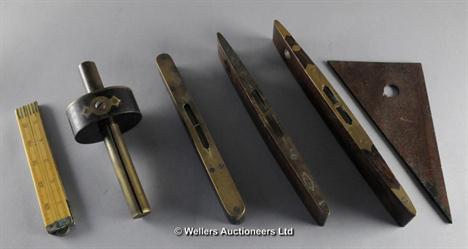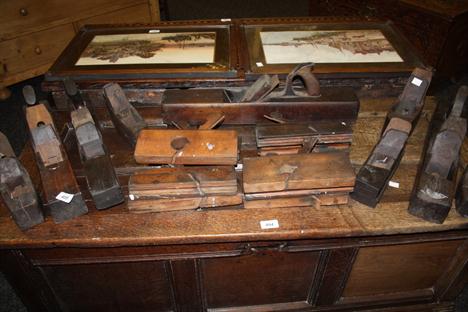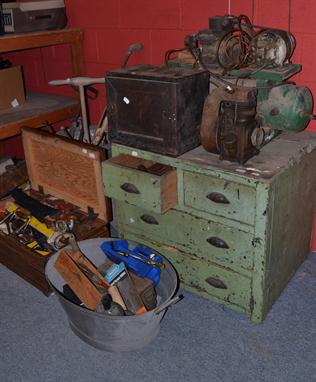We found 82067 price guide item(s) matching your search
There are 82067 lots that match your search criteria. Subscribe now to get instant access to the full price guide service.
Click here to subscribe- List
- Grid
-
82067 item(s)/page
A rare Lancashire wheel cutting engine. Inscribed for the original owner David Davies, London and dated 1776 The cutter frame with pivoted vertical movement against an adjustable screw-stop mounted onto the substantial box frame via a screw-adjusted horizontal slide, the 15.25 inch brass circular index plate with forty two division rings ranging from 6 to 365 and engraved David Davies, LONDON with repeat name and dated MAY THE 29 1776 to inner margin, located via a sprung detent fixed to the front of the frame and with central arbor passing through the frame to hold the work, the whole on four down-curved spiked supports, length of frame 74cm (29ins); with a selection of accessories including cutter arbors and a copy of Crom, Theodore R. HOROLOGICAL WHEEL CUTTING ENGINES 1700-1900 published by the author, Gainesville Florida, second edition 1976, (2). The overall design, construction and layout of the current lot can be directly compared to an engraving of an English wheel cutting engine published in Enderson, William The Principles of Mechanics, second edition 1758 (see Crom, Theodore R. Horological Shop Tools 1700-1900 page 634). An almost identical engine (signed for Daniel Fenn, London) is illustrated in Crom, Theodore R. HOROLOGICAL WHEEL CUTTING ENGINES 1700-1900 page 93; another from the workshop of the late John Hooper was sold in these rooms Tuesday 10th February 2009 lot 47. David Davies is recorded in Loomes, Brian Watchmakers & Clockmakers of the World, Volume 2 as working in London during the second half of the 18th century; as such engines are thought to have been made in Lancashire it is most probable that he was the original owner rather than the maker.
An English silver cased verge fusee pocket watch Henry Hindley, York circa 1760 the case later The gilt full-plate movement with square baluster pillars, silvered regulation dial, finely engraved and pierced foliate engraved backcock with diamond endstone and signed H. Hindley, York, 842 to the frosted gilt backplate, the dust cover with conforming signature, the circular white enamel Roman numeral dial with gilt spade hands now in a plain case with post and suspension loop at 12 oÕclock, case marked for London 1827 makerÕs mark HJ, (case with wear, outer case lacking), diameter 4.4cm. Henry Hindley was born in Great Harwood, near Blackburn, Lancashire 1699. Little is known about his early life, however by the mid 1720Õs he was making clocks in Wigan where he repaired the church clock in 1720. Hindley moved with his young family (including his son, Joseph born 1728) to the city of York where, after making clocks for the Mansion House and Guildhall, he gained his Freedom of the city in 1732. HindleyÕs talents were such that he equipped his workshop with tools of his own design including an important dividing and wheel cutting engine, a screw cutting lathe and a fusee engine. As well as for domestic clocks Hindley received commissions for many turret clocks including York Minster and supplied a range of scientific instruments including two important equatorial telescopes for the Duke of Norfolk and William Constable. By the 1760Õs HindleyÕs health had deteriorated to the extent that an increasing proportion of the business was handled by his son, Joseph. Henry died in 1771 with his son and successor Joseph unfortunately dying just three years later in 1774.
A cased pair of double-barrelled flintlock pistolsdating: circa 1800provenance: FranceRound, turn-off, 11 mm cal. barrels with longitudinal rifling; boxlock-type frames engraved at the borders, top hammers with safety lock, foldaway triggers, wooden butts with old, collection number. In a wooden case lined with original, green cloth, complete with all tools.dimensions: length 18.5 cm.
A cased pair of percussion pocket pistolsdating: mid-19th Centuryprovenance: BelgiumRound, smooth, turn-off, 11 mm cal. barrels with longitudinal risers; boxlock type frame, finely engraved with floral motifs, stamp of Liège test bench, foldaway triggers, checkered and sculpted ebony butts, butt-plates with iron drums. Modern, wooden case, provided with rod and bullet mould with tools.dimensions: length 21 cm.
A cased pair of percussion pistols by Forseythdating: mid-19th Centuryprovenance: EnglandSmooth, octagonal, 13 mm cal. barrels, marked "FORSEYTH & CO. PATENT LONDON", fore -and rear-sight, at the base a silver frame; forward spring locks signed "FORSEYTH & CO PATENT", engraved with floral motifs and provided with safety lock; wooden full stocks with checkered butts; iron trigger guard engraved en suite, articulated iron ramrods. In a wooden case lined with green cloth, with "Forseyth" label and some tools.dimensions: length 37 cm.
A fine pair of cased percussion pistols by Thomas Lloyddating: second quarter of the 19th Centuryprovenance: EnglandSmooth, octagonal, twisted, 12 mm cal. barrels signed "THOMAS LLOYD LONDON" with fore -and rear-sight; blued bases and tangs, finely engraved with floral motifs; forward spring locks signed "THOMAS LLOYD", engraved and blued en suite, provided with safety lock, piston with spark-arresters; three-quarter wooden stocks checkered at the butts, iron mounts decorated en suite; set triggers; brass-tipped wooden ramrods. In their wooden case with brass mounts (foldaway handle at the cover), green cloth lining, with all tools including Skyes copper powder-flask, bullet-mould, two screwdrivers, primer case, etc. Complete with key. Scarce signature.dimensions: length 41 cm.
A cased pair of Smith & Wesson New model n. 3 revolversdating: last quarter of the 19th Centuryprovenance: USAA pair of Smith & Wesson New Model n. 3 revolvers, 44 Russian caliber, with target sights, six inches barrels, in original fitted rosewood veneered case with "Boulle" brass decoration and red velvet relined, with all the original S&W reloading tools and with the rare bulletmould. Cleaning ramrod missing.The guns preserve more than 90% of original finish, with some spots, and about 100% of case hardening color on hammers and trigger guards. Both bores are in perfect condition.dimensions: length 30,5 cm.
A beautiful double-barrelled percussion gunby Lepagedating: mid-19th Centuryprovenance: ParisSmooth, round, blued, damask, 16 mm cal. barrel, provided with rib with golden signature "Damas Superfin", gold and silver decorations at the base, silver foresight; long, engraved tang; backward spring locks, signed "Lepage" and "A Paris", and engraved with fine floral motifs; butt of beautiful, shiny briarwood, outstandingly sculpted with bas-relieved floral motifs and high relieved head of lion at the lower part of the butt; silver mounts engraved en suite, stamped, the trigger guard decorated with high relieved leaf; silver-tipped wooden ramrod with brass and iron cartridge extractor. In its original, wooden case lined with red velvet, complete with all tools, manufactured with the same quality of the shotgun. Complete with key.dimensions: length 120 cm.
-
82067 item(s)/page

















































